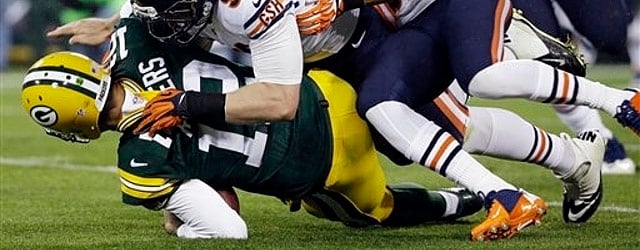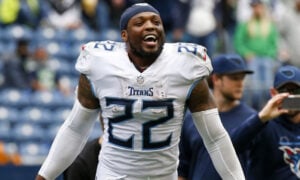Injury Update: Aaron Rodgers

Injuries in the NFL continue to plague fantasy football owners and NFL players. Fantasy football players have suffered through injuries to elite talent like Julio Jones, Michael Crabtree and Randall Cobb. Aaron Rodgers is now added to the list of elite talent stricken by the injury plague.
Rodgers was injured in the first quarter after being driven to the ground by Chicago Bears defensive end Shea McClellin. Rodgers’ left shoulder was driven into the ground, as McClellin landed on him. Rodgers jogged off the field, and did not seem to favor his left arm or shoulder at all. On Twitter, reports of a clavicle fracture leaked out, and yet Rodgers stood on the sidelines, no sling on, his left hand resting snuggly in the pocket of his jacket.
It was later confirmed that Rodgers did, indeed, suffer a fractured left collarbone. This is a common fracture, representing 2 to 4% of all fractures across all age groups.1 One study found 19 NFL players with mid-shaft clavicle fractures across five years, and this represents the most common clavicle fracture (86%).1,2 That Rodgers was able to jog off the field without holding his left arm, and did not require a sling on the sidelines, suggested the injury was not a severe, displaced fracture of his collarbone. After the game, it was confirmed by Rodgers that he did suffer a fractured left clavicle. Initial estimates on recovery time by various media outlets are 3 to 6 weeks, and based on my research, it seems like 6 weeks may be more realistic.
Clavicle fractures are divided into three groups:
Group 1:
Midshaft or middle third of the clavicle fractures. These are the most common fractures of the clavicle (86%). The middle part of the clavicle is flat, at its weakest point, and is hence more likely to get fractured.
Group 2:
Distal or lateral fractures of the clavicle, nearest to the shoulder joint, at the acromial end, are the second most common fracture (16%). These are further subdivided into five types, based on the location of fracture relative to nearby ligaments (coracoclavicular ligaments). Of interest to Rodgers, Type I is usually non-displaced as the fracture is located lateral to the coracoclavicular ligaments, and these ligaments help hold the medial fragment in place. Type III fractures are similar to Type I fractures, but they also involve the acromioclavicular (AC) joint. Both Type I and III fractures are typically treated without surgery, as they are usually non-displaced. Incidentally, displaced fractures occur when both ends of the fractured bone are no longer aligned, and are moved away from each other. Displaced fractures may or may not require surgery and are at a higher risk of bone non-union, cosmetic defects and complications from the injury itself (vascular or neurological compromise and a deflated lung).
Group 3:
Medial or sternal fractures of the clavicle are located nearest to the sternum or chest, are are the least common fracture (2%).
The diagnosis is typically made both clinically and using radiological examinations, mainly x-rays. Patients will have pain when the clavicle is gently touched, or when movement of the shoulder is attempted. A crunchy sensation may be felt with shoulder movement. X-rays will usually show the location and extent of the fracture, including whether there is displacement or not.
Treatment and prognosis depend on the location of the fracture (medial, midshaft or distal/lateral fracture) and whether it is displaced or not. Advanced age is another factor, but that is usually not as much of an issue for NFL players, as the average age for this injury in the NFL is 25 years old.2 The literature quotes 6 weeks to see evidence of bone union on x-rays. Midshaft clavicle fracture healing typically takes 6 to 12 weeks in adults.1 Distal or lateral clavicle fractures typically take 6 to 8 weeks for sufficient healing (Types I and III). Return-to-play is advised once an athlete has no pain, there is full range of motion in the shoulder, and normal strength. Return-to-play is typically 6 weeks for non-contact sports, and 8 to 12 weeks for contact sports (football).
It has been reported that Aaron Rodgers has a 3 to 6 week window for return-to-play. This appears to be a bit optimistic based on published evidence. That said, we do not have his imaging available, nor do we know the full details of his injury. Such is life in trying to estimate how these injuries will impact our fantasy teams. It is possible Rodgers has a very small, non-displaced fracture, and maybe that is reason for optimism from his medical team. I would not bet against NFL physicians and trainers. However, unless Rodgers is Wolverine from the X-Men, bone union takes time, no matter who has the injury. The key point here is how long it will take Rodgers’ bone to fully heal, and for pain to go away. If Rodgers returns too soon, he is at risk for breaking it again, possibly more severely. It helps that the fracture is on his non-throwing shoulder, but if the bone is not properly healed, NFL-level hits could break it again.
Hopefully initial estimates are accurate, but I do think fantasy owners should begin preparations now for alternatives just in case Rodgers does not heal has fast as is currently projected. If Rodgers’ recovery extends out 6 weeks or more, that would put him at risk for missing the fantasy playoffs, and that is obviously a big deal for fantasy football owners. If the Packers are out of contention, they might even decide to keep Rodgers on the sidelines, similar to Tony Romo in 2010. In fact, fantasy owners were hopeful to have Romo back for the fantasy playoffs, only to have their hopes dashed at the end. Romo’s initial projection for recovery was 4 to 6 weeks, but he ended up missing the final 10 games of the year. It seems like Rodgers injury is not as severe, so again hopefully he will have a faster recovery than Romo. Outcomes for players with fractured clavicles are excellent, so this should not impact Rodgers’ dynasty value long-term. In fact, for owners whose dynasty teams are no longer in contention, acquiring Rodgers from a contending team desperate for a quarterback is a very good strategy this year. In re-draft leagues, get a good back-up quarterback, and be prepared to use him if Rodgers’ recovery rolls into the fantasy playoffs.
References:
1. Pujalte GGA and Housner JA. Management of Clavicle Fractures. Current Sports Medicine Reports (American College of Sports Medicine), 2008; pp 275-280.
2. Morgan RJ, Bankston LS, Hoenig M, at al. Evolving Management of Middle-Third Clavicle Fractures in the National Football League. The American Journal of Sports Medicine, 2010; 38(10): pp 2092-2096.
[ad1]
- Dynasty Capsule: Carolina Panthers - February 3, 2017
- The Dynasty Doctor: CJ Anderson - January 25, 2017
- The Dynasty Doctor: Week 15 - December 20, 2016


































































